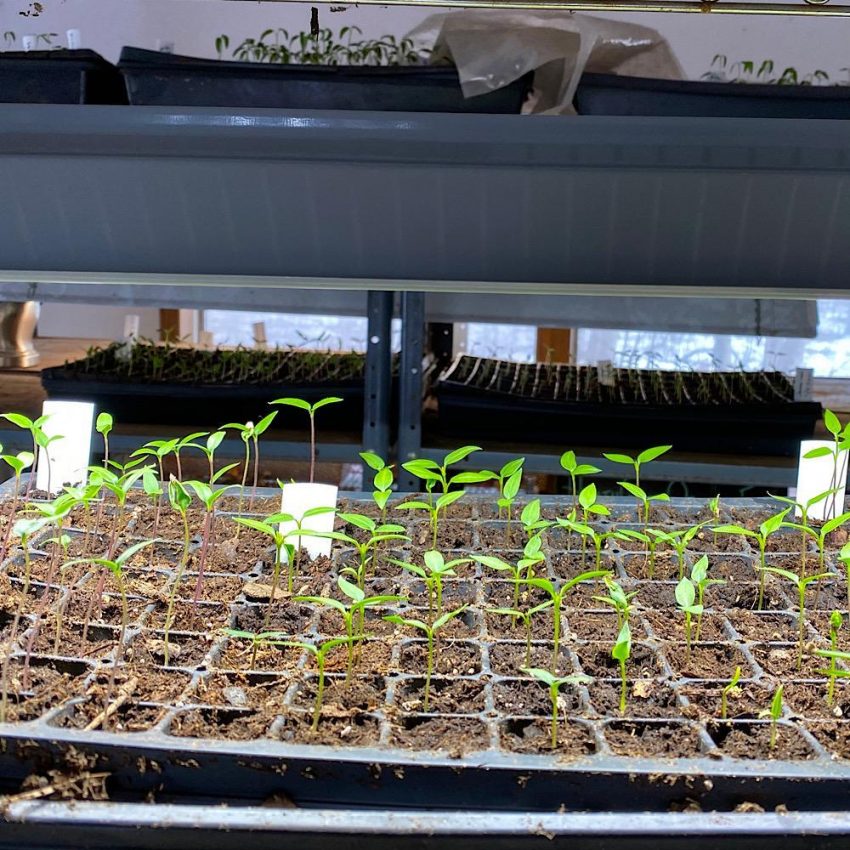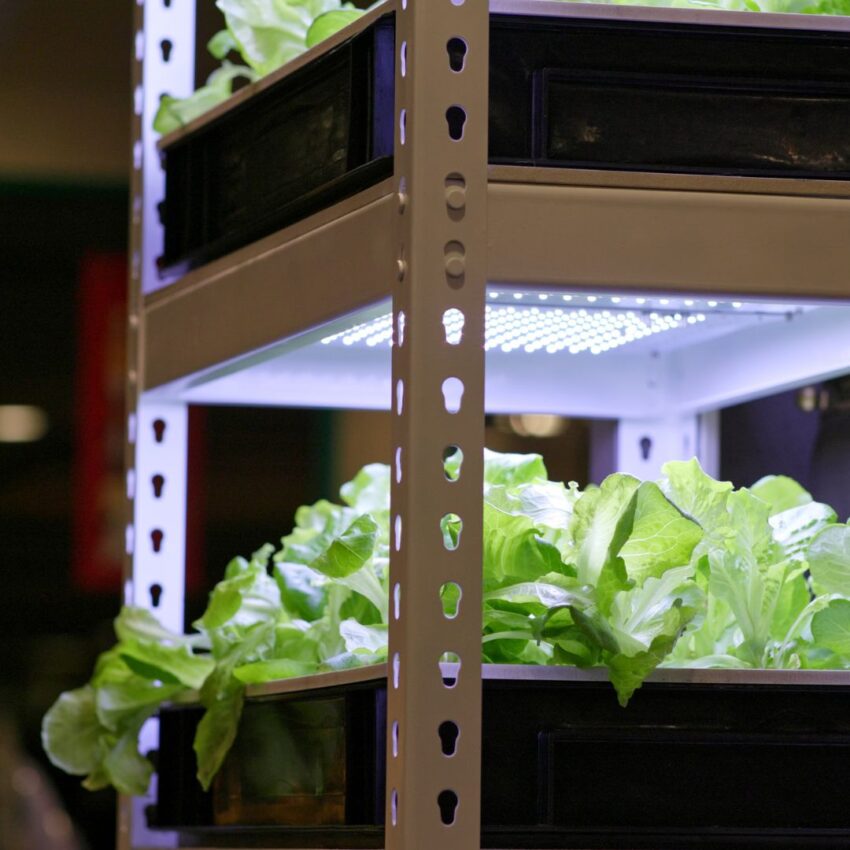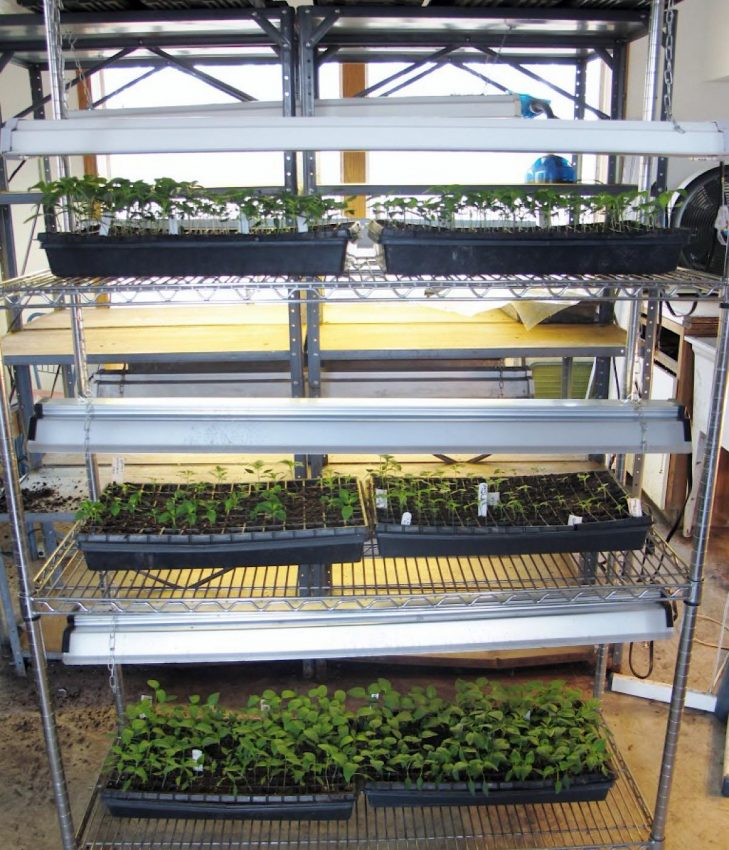There are very scientific, detailed studies available regarding indoor seed starting with LED lights. This post is a summary of my experience using both LED and fluorescent lights as grow lights for starting tomato and pepper seeds indoors.

Jump to: LED vs Fluorescent | Cost Comparison | LED Impact on Seedlings | Troubleshooting | Video
This post may contain affiliate links. As an Amazon Associate, I also earn from qualifying purchases. You can read our disclosure information here–
Comparing LED to Fluorescent Shoplights
I am going to summarize the differences between using LED and fluorescent lights, with a focus on my experience with starting heirloom tomatoes and chile peppers.
I found it useful to break down the information into five main categories:
- Cost comparison
- Energy uptake of seedlings (lumens vs. watts vs. color spectrum)
- Distance of lights from seedlings
- Photoperiod & duration of lights on seedlings
- Troubleshooting
1. Cost of LED lights vs fluorescent
Led shoplights, with the lights embedded in the fixture, will cost more than just replacing fluorescent bulbs in your existing fixtures. The cost of LED shoplights is primarily dependent on the “lumens” it puts out and the size of the fixture you need.
I bought 5000 lumen shop lights at Walmart for $18.97 each and 3200 lumen shop lights for $14.97 each. However, after doing more research on speed of growth I will be exchanging the 3200 lights for 5000.
The 5000 lumen LED grow lights seem to be better for growing tomatoes indoors.
A couple of other things to be aware of regarding the long term cost of fluorescent and LED lights used for seed starting is:
- The fluorescent bulbs break easily if you are clumsy like me or working in awkward spaces, and when they break the shatter and emit a nasty gas
- It is getting harder to find fluorescent bulbs and they may not be available for much longer. They did not stock them any more at our local Walmart or Menards. You may be able to still find some but I think they are being phased out.
- Higher intensity LED grow lights can quickly get into hundreds of dollars. Your space needs along with the volume of plants you want to start will determine the cost. Gardener’s Supply company has great information on costs of LED lights for growing seeds, whether you want to grow one flat on a tabletop or many flats under an array of shop lights.
- Anecdotally, I have heard that the LED lights available from Amazon are not the highest quality. I would read the reviews before ordering from Amazon.
2. Impact on Seedlings of LED grow lights
There are really only two main components of LED grow lights that impact the growth of your seedlings, lumens and the color spectrum. Watts only impact the cost of the electrical energy.
Here is an overall summary of the three components impact on seedlings:
- Lumens: the amount of lumens corresponds to the amount of growable energy plants can uptake. It is directly proportional to how far away the lights should be from the plants
- Watts: this only relates to the amount of electrical energy the lights use and is not relevant to plant growth
- Color spectrum: The main “colors” that impact plant growth in grow lights are blue (cool), red (warm), and full spectrum.
The blue part of the spectrum impacts “vegetative” growth and is the most important color if you are just growing seedlings that will later be put outside for flowering. In fluorescent bulbs, these would be the bulbs that say “cool”
The red part of the spectrum relates to “flowering” growth and is important if you are growing plants indoors that you want to encouraging flowering.
The LED lights that I bought are considered ”daylight”. They will have a bit of both blue and red, but they tend to have more of the cool light. The light they give off is very bright and looks white.
You can also purchase ”dual lights“ , which have one red bulb and one blue bulb. They give off a violet light, and if you are starting seeds in your home you will get a disco feel from these dual lights!

3. How Far Away Should Grow Lights be From Seedling Plants?
As mentioned above, the amount of lumens is directly proportional to how far away the lights should be from the plants. With the 5000 lumen LED lights, a good range would be around 4 inches. When I was using the fluorescent lights I needed to keep them very close to the plants, at about 1-2 inches.
LED light energy will cover a wider range of area also. It will extend to the edges of the trays, whereas the fluorescent bulbs only give off the productive energy to the plants directly under the bulbs. For me this has been a significant space-saver (but I grow thousands of plants).
You will need to test the height around your particular set up and light. Follow the trouble-shooting tips below and adjust the height if needed.

How Long Should Grow Lights be Above the Plants?
Most information you see on duration time notes that 16 hours is best for seedling growth. Some people believe that 24 hours is harmful, but that is up for debate.
The energy from the lumens that the plant uptakes is cumulative. This means that if you are growing your seedlings in a dark closet or basement with no supplemental or ambient light, you can probably leave the grow lights on for 24 hours without a problem.
I grow my plants in a shop with a lot of windows and have found the sweet spot to be 14-16 hours.
Troubleshooting Health of Seedlings
Without getting technical, here are a few tips that should help in successfully growing seedlings under LED lights:
- Led lights will result in faster growth of your seedlings, so you need to plan for that. I live in Minnesota (zone 4) and time my seedlings for hardening off in April. If they grow too fast, they would be at the stage to harden off (2 sets of leaves above the seed leaves) in March and the cool weather would be problematic.
- If your seedlings are a purple tone, it usually means they are getting too much light (or they need to be potted up to fresh soil). Decrease the light duration.
- If your seedlings are turning yellow at the top, the light is too close. Adjust the height.
- Different plants have different daylength requirements (known as photoperiod). This is actually the amount of time a plant needs uninterrupted darkness to grow and thrive. Poinsettias, for example, need long periods of darkness to flower and therefore the light needs to be manipulated. Tomatoes are considered day length neutral, but know that once tomatoes reach the flowering stage you need to back off of the light duration or you will have reduced production
- This detailed how-to guide will help you through the entire seed starting process
Basically, tomatoes should be outside before they reach the flowering stage. If you see tomatoes at the market or the store that are in small pots and have already blossomed, you will most likely not get as many tomatoes from that plant. Same with peppers.
Video: Growing Plants Indoors under Grow Lights
This video will show the details of growing tomatoes and peppers indoors under LED light vs fluorescent lights.
If you like my articles about cooking and gardening, subscribe to my weekly newsletter, where I share free recipes and gardening tutorials.


Well written and good information . What you address regarding growing environment is usually ambient light and can be enhanced by having surfaces of a higher reflectance value around your seed starting area.
Thank you! Definitely something to be aware of and a way to enhance.
The focus on lumens really is not helpful, and shows that perhaps the author doesn’t have a complete understanding of the topic.
Lumens are a measure of the total quantity of visible light. The problem is that lumens are based on what the human eye can perceives, via the “luminosity function”. It weighs light spectrums we perceive as brighter (green) as higher lumens than red/blue light.
This means that a high lumen light may actually have less useful light (to a plant) than another light source with a lower lumen count. This isn’t even taking into consideration light like IR and ultraviolet light outside of the visible spectrum. I would go as far as saying that lumens are basically useless when talking about plant growth.
So sorry you didn’t find it helpful. I’m certainly no pro. Just sharing my experiences so far.
I switched to LED shoplights this year, after using Fluorescents for 20 years. My tomatoes and peppers stopped growing after they were 3 inches tall. Even after moving them them to sunlight, they didn’t grow. Other vegetables and flower seedlings grew well. Any ideas?
Hmmm, I’d have to know a little more as my trials with tomatoes and LED has worked out well. Was everything else exactly the same as with the fluorescents? Same potting soil, same watering regime, same start time, same varieties? I’d also look at the time they spent in small plugs. Were they root bound at all and needed to be potted up? Overwatering can be a problem and cold soil for prolonged periods can stunt growth.
Thanks for the information. I have been planning to add indoor lighting for my seedlings and now especially that I replaced my windows which have UV protection. Now I am no expert on the science light spectrum and such but I have noticed that this is probably the reason my seedlings are of poorer quality than before my window change (all other growing aspects being equal). Your article helps convince me that I need extra lighting.
Hi Ken, As a previous “window starter”, I can’t emphasize enough how much tomatoes and peppers love light that is close to the plant so they are not reaching for the sun. This article might help a bit if you have had trouble with leggy tomato seedlings: https://farmtojar.com/leggy-tomato-seedlings/
I started using full spectrum LEDs this year after decades of using fluorescent. My tomatoes turned purple and curled their leaves. The peppers looked okay but just stoped growing. Everything else, eggplants, cauliflower, broccoli and a few pansies did fine. After doing some research it looks like I had the lights too close and kept them on too long. Does that sound right?
Very frustrating; I lost hundreds of plants. Unless I get this figured out I’m going back to fluorescents.
That does sound right. I did notice that the LEDs seemed to be much stronger. They tend to like the lights on about 16 hours but then a period of darkness after that to rest is helpful. I don’t think they’re better than fluorescents actually, but it’s hard to find the fluorescent shop lights anymore. Stock up if you can find them and go with tried and true. But even with the fluorescents, 16 hours under lights should be the max in a 24 hour period.